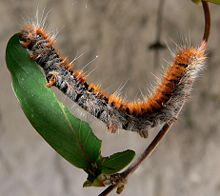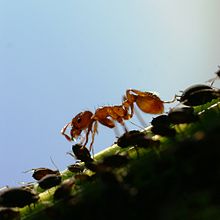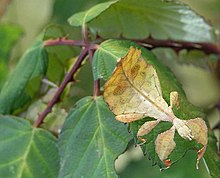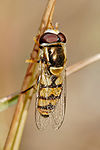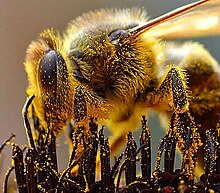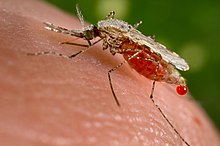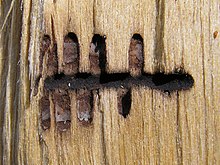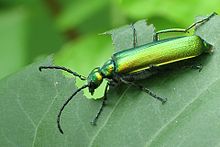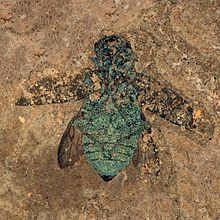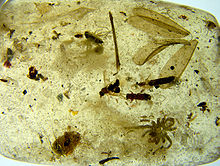Insect
The insects (Insecta) are a class of invertebrate animals of the arthropod phylum, characterized by having one pair of antennae, three pairs of legs, and two pairs of legs. wings (which, however, may be reduced or missing). The science which estudies bugs is named entomology. Its name comes from the Latin insectum, a calque of the Greek ἔντομα, 'cut in the middle'.
Insects comprise the most diverse group of animals on Earth with approximately one million described species, more than all other animal groups combined, and with estimates of up to thirty million undescribed species, thus, potentially, they would represent more than 90% of the forms of life on the planet. Other more recent studies reduce the number of insects to be discovered to between six and ten million species.
Insects can be found in almost every environment on the planet, although only a small number of species have adapted to life in the oceans. There are approximately 6,000 species of Odonata (dragonflies, damselflies), 20,000 Orthoptera (grasshoppers, crickets), 120,000 Lepidoptera (butterflies and moths), 160,000 Diptera (flies, mosquitoes), 9,800 Dictyoptera (cockroaches, termites, mantises), 5,200 Ptyraptera (lice), 1,900 Siphonaptera (fleas), 82,000 Hemiptera (bugs, aphids, cicadas), 375,000 Coleoptera (beetles, ladybugs), and 153,000 Hymenoptera species (bees, wasps, ants). However, insect biodiversity is declining rapidly. More than 40% of insect species are threatened with extinction, with Lepidoptera, Hymenoptera and Coleoptera being the most affected by this decline.
Insects are not only highly diverse, they are also incredibly abundant. Some anthills contain more than twenty million individuals and it is estimated that there are 1015 ants living on Earth. In the Amazon rainforest there are an estimated 60,000 species and 3.2 × 108 individuals per hectare. It is estimated that there are 200 million insects for every human being.
Terrestrial arthropods such as centipedes, millipedes (Myriapoda), spiders, scorpions (Chelicerata), and mealybugs (Crustacea) are often confused with insects because they have similar body structures, but are easily distinguishable, as that insects have three pairs of legs, while scorpions and spiders have four pairs and no antennae, sowbugs have ten pairs of legs and can coil, and centipedes and millipedes have many pairs of legs.
External Anatomy
The body of insects is made up of three main regions (called tagmata): head, thorax and abdomen, evenly covered by an exoskeleton.
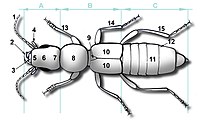
Exoskeleton
The exoskeleton or ectoskeleton is the external skeleton that covers the entire body of insects and other arthropods, it is also known as the integument. In insects it is formed by a succession of layers; from the inside out these are: the basement membrane, the epidermis or hypodermis and the cuticle; the only cell layer is the epidermis; the rest do not have cells and are composed of some of the following substances: chitin, arthropodin, sclerotin, wax, and melanin. The rigid component, sclerotin, fulfills several functional roles that include the mechanical protection of the insect and the support of the skeletal muscles, through the so-called endoskeleton; in terrestrial insects, the exoskeleton also acts as a barrier to prevent desiccation or loss of internal water. The exoskeleton appeared for the first time in the fossil record about 550 million years ago and its evolution has been critical for adaptive radiation and the conquest of almost all the ecological niches on the planet that arthropods have been carrying out since the Cambrian.
Head
The head is the anterior region of the body, in the form of a capsule, which bears the eyes, antennae, and mouthparts. Head shape varies considerably among insects to allow room for sensory organs and mouthparts.
The head of insects is subdivided by sutures into a number of more or less differentiated sclerites that vary between the different groups. There is typically a "Y" inverted, extending along the dorsal and anterior part of the head, bifurcating above the ocellus to form two divergent sutures, which extend downwards on the anterior sides of the head. The dorsal part of this suture (the base of the Y) is called the coronal suture and the two anterior rami the frontal sutures. On the other hand, the head of insects is constituted by a preoral region and a postoral region. The preoral region contains the compound eyes, ocelli, antennae, and facial areas, including the upper lip, and the postoral part contains the mandibles, maxillae, and lip.
Internally, the exoskeleton of the insect head capsule invaginates to form branches of the tentorium which serves as a site of muscle attachment and support for the brain.
Eyes
Most insects have a pair of relatively large compound eyes, located dorsolaterally on the head. The surface of each compound eye is divided into a number of circular or hexagonal areas called facets or ommatidia; each facet is a lens of a single visual unit. In addition to compound eyes, most insects have three simple eyes, or ocelli, located on the top of the head, between the compound eyes.
Antennas
They are multi-jointed mobile modified appendages. They occur in even numbers in adult insects and most larvae. They are made up of a variable number of knuckles called antenomeres or small antennas. The role of the antennae is eminently sensory, performing several functions. The tactile function is the main one, thanks to the tactile hairs that cover almost all the antennomeres; they also perform an olfactory function, provided by olfactory areas in the form of sieved plates with microscopic pores distributed over the surface of some terminal antennomers. They also have an auditory function and sometimes a grasping function during copulation or mating, by holding onto the female. They are made up of three parts, the first two being unique and uniarticulate and the third comprising a variable number of antennomers and are called respectively: scape, pedicel and flagellum or funicle.
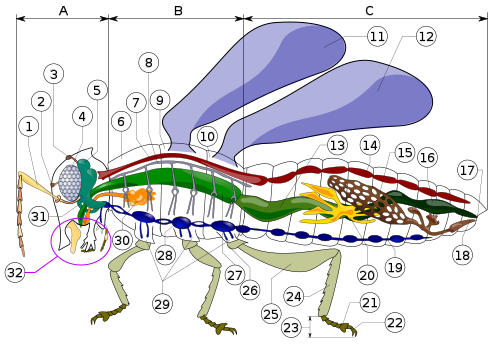
Mouthparts
They are mobile parts that are articulated in the lower part of the head, intended for feeding; they crush, gnaw or chew solid or hard food and absorb liquids or semi-liquids. The mouthparts are as follows:
- Lab (top lip or simple lip). It is a variable imparity with movements up and down; it is the roof of the mouth and it is articulated with the clip. In its inner face is the epipharynx, which is not a free piece, is slightly sclerosed and has its taste function.
- Mandibles. They are two simple pieces, laterally arranged under the upper lip, articulated, resistant and sclerosed. Its function is to chew, crush or lacerate food. In some adults they may be totally absent or vestigeal in the whole of the lepidopters and ephemeropteros.
- Maxilas. In number two, they are located behind the jaws. Articulated in the lower side of the head, are auxiliary parts during feeding. Hypofaringe is an outgoing structure, located on the chin with taste function. It looks like the tongue. The maxillas have a maxillary palpo each.
- Labio (labium). Unstoppable structure resulting from the fusion of two independent structures located behind or under the jaws and representing the floor of the mouth; it presents two small lipsticks.
Main Types of Oral Appliances
The mouthparts of insects have been modified in various groups to adapt to the ingestion of different types of food and by different methods. The most differentiated and interesting types are mentioned here, chosen to illustrate the various forms adopted by homologous parts, and the different uses to which they can be applied. There are many other types, many of which represent intermediate states between some of those cited here.
- Chewing guy. In this type of mouthpiece the appendices are essentially jaws, maxilla and lip. The jaws cut and crush solid foods and the maxilla and lip push them to the esophagus. The mouthpiece of a chewing type is the most generalized among insects and, from it, the other types have been developed (see figure below on the right). This point of view is based on two kinds of important tests. First of all, this oral apparatus is the most similar in its structure to that of miriapods who are the closest relatives of insects. Second, the mouth chewing apparatus is found in almost all orders of insects such as the orthopter, the coleopter and the lepidopteros larvae.
- Type cutter-shimmer. This type of mouthpiece is found in the Tabanidae (Diptera Tabanidae) and some other dipters, the jaws are presented in the form of sharp leaves and the maxillae in the form of long probe stylings. Both cut and tear the cleavage of the mammals, causing the blood of the wound to flow. This blood is collected by the spongy protuberance of the lip and led to the end of the hypopharynx. The hypo and epipharynx are adjusted to form a tube through which the blood is aspirated to the esophagus.
- Sucker guy. A large number of non-spicking flies, including the domestic fly, have this type of mouth apparatus adapted only for the ingestion of liquid foods or easily soluble in saliva. This type is the most similar to the sucker cutter, but the jaws and jaws are not functional, and the remaining parts form a testose with a sponge-shaped apex (called label). It is introduced into liquid foods that are led to the food channel by tiny capillary channels existing on the surface of the label. The food channel is also formed by the elongated hindrances of the hypo and epipharynx that form a tube to the esophagus. Flies and other insects with this type of oral apparatus can also ingest solid foods such as sugar. To do this, they throw a drop of saliva on the food, dissolve it, and then the solution is suctioned to the mouth.
- Chess-lamedor guy. This type of mouthpiece, adapted to the absorption of liquids, is found in bees and wasps, exemplified by the common bee. The jaws and the lab are chewing type and use them to hold the dams and to mask the wax or other materials with which they build their nests. The maxillas and the lip form a series of depressed and elongated structures of which one of them forms a wide acanalized organ. The latter is used as a probe to reach the deep necrotes of the flowers. The other tongues of the maxilas and the lip form a series of channels through which the saliva descends and the food rises.
- Type spicy-scraper. The mouthpiece of many insect groups is modified to drill tissues and suck juices. Among them hemipteros (pulgones, chinches, pigs), predators of many classes, lice and fleas that suck the blood of mammals and birds. In this type of mouthpiece, the lab, jaws and jaws are thin and long, and gather to form a delicate hollow needle. The lip forms a robust pod that keeps this needle rigid. The entire organ is called peak. To feed, the insect tightens the entire beak against the host, thus inserts the needle into the inside of the tissues of the same and sucks its juices through the needle into the esophagus.
- Type siphon tube. Adult lepidopters feed on nectar and other liquid foods. These are supplied by a long testocide (spiritompa) composed only by a tube that flows into the esophagus.
Thorax
The thorax is the middle region of the body and contains the legs and wings (some adult insects are wingless and many immature insects and some adults are legless). The thorax is composed of three segments, prothorax, mesothorax, and metathorax, with each thoracic segment typically having a pair of legs and a pair of wings each (when present); when there is only one pair of wings, they are located in the mesothorax, except in strepsiptera that only keep the metathoracic wings; the prothorax is never winged.
The thorax is attached to the head by a membranous neck region, the cervix. There are usually one or two small sclerites on each side of the neck, which link the head to the prothorax.
Each thoracic segment is composed of four groups of sclerites. The noto dorsally, the pleurae laterally, and the sternum ventrally. Any thoracic sclerite can be located in a particular segment by the use of appropriate prefixes: pro-, meso-, and meta-. For example, the notum of the prothorax is called the pronotum.
The mesothoracic and metathoracic notations are frequently subdivided by sutures into two or more sclerites each. The pleura is a wing-bearing segment, it forms an alar-pleural process that serves as a support for wing movement.
On each side of the thorax are two slit-like openings, one between the prothorax and mesothorax and the other between the meso and metathorax. These are the stigmata, that is, the external openings of the tracheal system.
Legs
They typically consist of the following segments:
- Coxa, basal segment
- Trocánter, small segment, (rarely two segments), following the coxa
- Fémur, first long leg segment
- Tibia, second long leg segment
- Tarsus, composed of a series of small segments (tarsomers) after tibia. The number of tarsal segments in different insects varies from one to five. The last tarsal segment usually contains a pair of claws or nails and often one or more structures in pillow shapes, between or at the base of the nails. A pillow or lobe between the nails is usually called arolium and pillows located at the base of the nails are called fleas.
Wings
Insect wings are outpouchings of the body wall located dorso-laterally between the notae and the pleurae. The wing base is membranous, this makes movement of the wing possible.
The wings of insects vary in number, size, shape, texture, venation, and in the position in which they are held at rest. Most adult insects have two pairs of wings, located on the meso and metathorax; some, like Diptera, have only one pair (always located in the mesothorax except in strepsiptera that have them in the metathorax) and some do not have wings (for example, wingless forms of aphids, worker ants, fleas, etc.).
In most insects the wings are membranous and may contain small hairs or scales; In some insects the forewings are thickened, leathery or hard and sheath-shaped, this structure is known as the elytra (in Coleoptera). Bedbugs have the first pair of wings thickened at their base; these types of wings are called hemiélitres. Locusts, crickets, cockroaches, among other primitive insects have the first pair of wings narrow and with a parchment consistency; these are called tegminas. The membranous wings of insects are used to fly, those hardened as is the case of the elytra, hemiélitra, tegminas, when folded they serve as protection for the second pair of wings, which is delicate because it is membranous, and also for the abdomen. The wings are also important to produce certain sounds, to disperse odors and, due to their design, are important in camouflage and mimicry.
Most insects are able to fold their wings onto their abdomens when at rest, but more primitive groups, such as dragonflies and mayflies, are unable to do so and keep their wings extended to the sides or above the body.
Some insects, such as male crickets and locusts, are capable of producing a characteristic sound with the wings rubbing the two forewings against each other, or the forewings with the hind legs.
Many insects, such as flies and bees, move their wings so rapidly that a buzzing noise is produced. The buzz, due to its sound frequency, is a specific character and in insects such as mosquitoes or female mosquitoes, it is an element used by the females to attract the males that fly in a swarm.
Insects are the only invertebrates capable of flight. In the Carboniferous, some Meganeura (a group related to modern dragonflies) had a wingspan of 75 cm; the appearance of giant insects seems to have a direct relationship with the oxygen content of the atmosphere, which at that time was 35%, compared to 21% today; the insects' tracheal system limits their size, so high oxygen concentrations allowed for larger sizes. i>) are much smaller.
In addition to active flight, many small insects are also dispersed by the wind. This is the case with aphids that are often carried long distances by air currents.
Stomach
The abdomen of insects typically has 11 segments, but the last one is greatly reduced, so that the number of segments rarely appears to be more than 10. The genital segments may contain structures associated with the external openings of the genital ducts; in the male these structures are related to copulation and the transfer of sperm to the female; and in females they are related to oviposition.
At the end of the abdomen there may be appendages, which arise from segment 11 and are the cerci, with a sensory, defensive or reproductive function.
Internal anatomy
Digestive system
The digestive system of insects is a tube, usually somewhat coiled, that extends from the mouth to the anus. It is divided into three regions: the stomodeum, the mesenterum, and the proctodeum. Some portions are widened, serving as storage, for example the Crop. Separating these regions are valves and sphincters that regulate the passage of food from one to the other. There is also a series of glands that lead to the digestive tract and help digestion.
Respiratory system
The respiratory system of insects is made up of tracheae, a series of empty tubes that together form the tracheal system; respiratory gases circulate through it. The tracheas open to the outside through the stigmas or spiracles, initially a pair in each body segment; then they progressively reduce their diameter until they become tracheoles that penetrate the tissues and provide oxygen to the cells. In tracheal respiration, the transport of respiratory gases is completely independent of the circulatory system, therefore, unlike vertebrates, the circulatory fluid (hemolymph) does not store oxygen.
Circulatory system
As in other arthropods, the circulation is open and lagoonal, and in insects it is simplified. The circulatory fluid is the hemolymph that fills the general body cavity, which for this reason is called hemocele, which is subdivided into three sinuses (pericardial, perivisceral, and perineural). The heart lies dorsally in the abdomen within the pericardial sinus; It has a valve in each metamere that delimits several compartments or ventricles, each with a pair of holes or ostioles through which hemolymph enters when the heart is dilated (diastole). The heart is prolonged forward into the aorta artery through which hemolymph exits when the heart contracts (systole); it usually branches to distribute hemolymph to the cephalic region. There may be accessory pulsatile organs in different parts of the body, which act as accessory hearts that ensure the arrival of hemolymph to the most distal points (antennae, legs).
Excretory system
The excretory apparatus of insects is made up of Malpighian tubes. They are blind tubes that float in the hemocele, from where they capture residual products and flow into the final part of the digestive tract where they are evacuated and eliminated with feces. They are capable of reabsorbing water and electrolytes, thus playing an important role in water and osmotic balance. Their number ranges from four to more than one hundred. Insects are uricotelic, that is, they mainly excrete uric acid. Exceptionally, Malpighian tubes are modified into silk-producing glands or light-producing organs.
Some insects have additional excretory organs independent of the digestive tract, such as labial or maxillary glands, and storage kidneys (pericardial bodies, nephrocytes scattered throughout the hemocoel, epidermal oenocytes, and urate cells).
Nervous system
The nervous system consists of the brain and a ventral chain of nerves. The brain is in the head, it is subdivided into protocerebrum, deutocerebrum and tritocerebrum and in the subesophageal ganglion. They are all connected by nerve commissures. The nerve chain is like a rope ladder with pairs of ganglia corresponding to each segment of the insect's body. There are also sensory organs: antennae for olfaction, compound and simple eyes, auditory organs, mechanoreceptors, chemoreceptors, etc.
Perception
Many insects have highly refined organs of perception; in some cases their senses can perceive things outside the range of human sense perception. For example, bees can see in the ultraviolet spectrum and pick up patterns of light polarization, and certain male moths have a specialized sense of smell that helps them detect female pheromones many miles away; ants can follow the scent trails left by their mates in the dark.
Due to their small size and the simplicity of their nervous system, their processing of perceptions is very limited. For example, it is generally accepted that insect vision offers very low resolution of detail, especially at long distances.
On the other hand, they are capable of surprisingly fast responses to specific stimuli. For example, the reflex of cockroaches to run when perceiving in their rear fences any movement of air that reveals the presence of a danger around them, or the reflex of flies and dragonflies during the flight to avoid obstacles at high speed.
Social behavior
Social insects, such as termites, ants, and many bees and wasps, are the best-known families of social animals. They live together in large, highly organized colonies that are genetically similar to the point that in some cases they are considered superorganisms. The house bee is said to be the only invertebrate to have evolved a system of abstract communication symbols in which behavior is used to represent and convey specific information about the environment. In this communication system, called the bee dance, the angle of the dancing bee's position represents the direction relative to the sun and the duration of the dance represents the distance to the flower food source.
The communication system of bumblebees is not as advanced as that of the house bee, but they also have means of communication. For example, Bombus terrestris learns more quickly how to handle flowers when visiting a group of unfamiliar flowers if it sees a conspecific foraging on such flowers.
Only insects that live in nests or colonies demonstrate a true capacity for spatial orientation or fine navigation. This allows them to return to their nest, which may be within a few millimeters of many similar ones in the other members of the nest aggregation after a journey of several kilometres. In the phenomenon known as philopatry, insects that hibernate or go dormant demonstrate an ability to remember a particular location up to a year after they last saw it. Some insects migrate long distances to other geographic regions when the change occurs. of season (for example the monarch butterfly and the sphinx hummingbird).
Parental care
Eusocial insects (bees, wasps, ants, termites) build nests, protect eggs, and provide food for young. Instead, most insects lead very short lives as adults and rarely interact with their young after egg-laying. In addition to eusocial insects, a small number of insects exhibit parental behavior, at least guarding the eggs and in some cases continuing to care for the immature ones and even feeding them until maturity. Another simple form of parental care is the construction of nests or shelters and storage of provisions before laying the eggs. The adult does not come into contact with its young but has provided it with all the necessary food. This behavior is characteristic of the solitary species that make up the majority of bees and of the wasps of the superfamily Vespoidea.
Several families of Hemiptera have representatives who practice parental care. This is seen in some bed bugs of the superfamily Pentatomoidea where the mother remains with the eggs and then the nymphs. In the Belostomatidae family, it is the male that carries the eggs on its back until the nymphs emerge, that is, it is paternal care.
Three groups of insects have species that practice biparental care, that is, both parents care for the young: Blattodea, Coleoptera, and Hymenoptera. In the Blattodea family Blaberidae, nymphs are fed by both parents by trophalaxis, passing secretions and food from mouth to mouth. In Coleoptera, dung beetles in the family Scarabaeidae prepare a ball of feces for the brood and remain with it. Burying beetles (Nicrophorus and others of the family Silphidae) provide carrion for the brood. Among some members of the Hymenoptera family Sphecidae, such as Polistes, males guard and protect the nest.
Playback
Most insect species have separate sexes, morphologically distinct from each other, and must mate to reproduce. However, in addition to this type of sexual reproduction, there are species that can reproduce without mating, and this may even be the typical reproduction process in several of them. These species are called parthenogenetic and their type of reproduction is eminently asexual. This reproduction mechanism is quite distributed in most orders of apterygotes. Although still much less common, there are species of insects that are hermaphrodites, that is, they carry both functional sexes in the same individual (such as Icerya purchasi and Perla marginata).
A good example of a parthenogenetic species is the stick insect (Dixppus morosus). Males in this species are extremely rare, and females begin to lay unfertilized eggs as soon as they mature. These eggs develop and open normally, giving rise to new females. In this way, a generation of females, genetically identical to the previous one, succeeds another without interruption. This type of parthenogenesis, in which the ovules are produced without a reduction in chromosome number (without meiosis) and the females give rise to more females, is called thelytokic parthenogenesis and is the usual mechanism of reproduction among males. aphids
In a somewhat different way, a queen bee (Apis mellifera) can lay fertilized eggs (diploid) from which females emerge, and unfertilized eggs (haploid) from which males (the males) emerge. drones). In this case, in which parthenogenesis occurs from ovules that have arisen by meiosis and therefore there is a reduction in chromosome number, parthenogenesis is called arrenotoquic . This sex determination system in which females are diploid and males are haploid is called haplodiploidy. It combines sexual and asexual reproduction in an adaptive way and is fairly distributed among the Hymenoptera.
Most species of insects lay eggs (are oviparous). However, there are cases in which females give birth to their young, such as in aphids. The examples of viviparity, although scarce, are also very diverse. In some cases the egg is opened immediately before being laid; in others, such as the tsetse fly, it develops inside the mother's body and the young is not born until the pupal stage. In some parasitic insects (Strepsiptera, parasitic hymenoptera) a single egg laid in the usual way divides repeatedly until reaching a progeny of up to 2000 individuals, of the same genotype and sex, a phenomenon known as polyembryony. Polyembryonic larvae are sometimes cannibalistic, so few adults manage to establish.
A very unique method of reproduction is the process known as paidogenesis or neoteny. Miastor metraloas larvae, for example, can reproduce on their own from unfertilized eggs inside a large live larva. The new larvae grow as parasites in the body of their similar and when they are ripe to emerge, the original larva dies. The hatchlings repeat the process, so the number of larvae continues to increase, until they become adult insects.
Eggs can be laid singly or in groups, sometimes inside a protective structure called an ootheca. The shape and size of the eggs are as varied as the insects that lay them. Butterfly eggs, for example, are often intricately patterned, with a surface covered with numerous ridges and veins. Many insects lay their eggs in the roots, or in the shoots and tender tissues of plants, or inside cereal grains, and even inside other animals. The location where insects lay their eggs, while varied, is by no means random. The objective of carefully choosing the place of laying is always the same: to lay the eggs in the place where the newly hatched larvae are surrounded by food.
In most insects the reproductive life of a female is very short and all the eggs produced are laid in rapid succession in a very short period of time. However, in some other species, especially in the so-called social insects such as bees, ants and termites, the reproductive life of a female lasts up to three years. Queen termites, for example, are estimated to lay an egg every two seconds, day and night, for a period of 10 years. Since it is the only breeding adult in the community, the termite mound's population would rapidly decline without this rate of fertility.
Insect eggs
- Main article: Insect Egg
The insect egg is the stage of the insect's life that begins when the female gamete (“oocyte”) of the insect, and after fertilization the developing embryo, live protected by an external shell called the chorion, and ends when, at the end of the development of the embryo, the hatching of the first juvenile stage occurs outside the chorion. During the egg stage, the embryo develops at the expense of nutrients deposited within the chorion along with the oocyte, and must have sufficient permeability for gas and water exchange to occur. The egg as such is born in the reproductive system of the mother, when the nutrients and the outer shell around the oocyte are finished forming and the cells that form them die by cell apoptosis. Then, by various mechanisms, the egg is fertilized with semen from the father, which enters the oocyte through a pore in the chorion (semen entry can be facilitated by various mechanisms). At that time the embryo is formed that develops at the expense of the nutrients contained within the chorion. In general, fertilization occurs within the reproductive system of the mother and after she deposits the egg ("ovipone") in an external environment selected by her. The egg must have sufficient morphology and elasticity to pass through the mother's ovipositor. In the external environment, the immobile egg is exposed to attack by predators and pathogens; consequently, adaptations evolved that provide the egg with mechanical, chemical, or parental care protection. The egg is also exposed to future competition from the larvae for food (larvae generally have little mobility, especially when they are newly hatched), so the gravid female is adapted to strategically deposit eggs, for example places them spaced apart from each other, or close to an important food source for future juveniles.
The morphology of the mature egg is highly varied among orders of insects. The egg in a generalized scheme consists of an oocyte with nutrients, surrounded by the vitelline membrane (which contains more nutrients), and 4 layers of protective chorion. Oogenesis (the process of egg formation) is also quite evolutionarily conserved.
At the time of oviposition, volatiles can be released that are captured by individuals of the same or another species, which can modify their behavior according to the information obtained.
Egg cannibalism is not a rare phenomenon among insects, suggesting that it will have adaptive value.
The still new field of chemical ecology allows us to shed light on the relationships between the egg deposited on its substrate and the environment and its associated organisms, a situation that occurs from the moment of oviposition until the juvenile emerges from the egg. Complex and arms race relationships have been found with predators, parasites, pathogens, competitors, associated microorganisms, and hosts and host plants when present.
Metamorphosis
Metamorphosis is a post-embryonic development process by which insects reach their adult phase (imago), during which they reach sexual maturity and in pterygotes develop wings. According to the type of metamorphosis that insects undergo, they are classified as:
- Metaboles: juveniles do not differentiate themselves from adults except for sexual maturity and size.
- Hemimetábolos: gradual metamorphosis in which the pterotecas and the sexual organs are gradually developed, although the different juvenile phases are similar to each other and the adult, the changes in the last mude are more marked (e.g. wing appearance); the juveniles are called ninfa and there is no state of pupa.
- Holometábolos: complete metamorphosis (egg, larva, pupa and adult), in which the tissues of the adult originate from special groups of cells called imaginary disks, during a life cycle state known as pupa.
Ecology
Food
The diet of insects is extremely varied. Broadly speaking, the following can be distinguished:
- Fitphages. They feed on all types of vegetable products and often cause pests in crops; they highlight the leaves eaters (filophages, such as many lepidopteros caterpillars, orthopter and crysomélid choleopter) and wood where excavate galleries (xylophages, pollutants, lanterns, such as carvettes); there are also granivores (comen granules) Others eat fruits (lepidopteros, dipteros, and choleoptera) or roots (rizophages), and many hemipteros feed on the sap, for which they have a bucal appliance in the form of a styling that perforates the vegetable tissues. Various species of dipteros and choleopter are micetophages and live on mushrooms, feeding on their fifas and spores.
- Zoologists. Carnivores can be fed by living prey that they themselves capture (predators, such as the odonate or the coleopter carbide) or their fluids, such as blood (hematophages, such as dipters, hemipters). In this category, the parasites, both ectoparasites, which are fed from the outside (pulgae, chinches), and the endoparasites, penetrate into the interior of their hosts (strepsípters, some hymenopter). Some species with particular regimes, such as Aethina tumide, small beetle that feeds on wax and produces severe decays in the hives (aethinosis), the melted choleopter that eat keratin (plumas, hair, wool, horns) or the lepidopteros larvae that devour fabrics.
- Omnivores. They have a varied diet, taking all kinds of plant and animal products.
- Sapróphages or decomposers. They feed on organic matter, animal or plant, in decomposition. Among them are the necrophages, which decompose corpses, the saproxilophages that eat wood in decomposition, and the copróphages that recycle the excrements.
Interspecific relationships
Insects establish very diverse relationships with other organisms, which act as hosts, to achieve a benefit. Depending on the type of relationship, several levels of association can be distinguished, although often the limit between them is difficult to establish.
The commensal insects take advantage of the leftover food or the desquamation, shedding, excrement, etc.; of their host, which they do not harm. Anthills and termite mounds host many commensal insects, where they generally feed on stored food; They are called, respectively, myrmecophiles and termitophiles. Foleophilous insects live in mammalian burrows and nidicolous insects in bird nests, making it sometimes difficult to determine whether they are commensals or parasites.
Mutualism, in which two species derive mutual benefit from their relationship, is also present among insects; many ants graze aphids, which they defend from other insects and obtain in exchange a sugary liquid that the aphids secrete. Some ants and termites raise fungi in their nests, which they feed on; fungi find a stable and protected environment for their development. Pollination can also be considered as mutualism between insects and plants.
Many insects have protozoa, bacteria and symbiotic fungi in the digestive tract, Malpighian tubes, gonads, hemocoel, etc.; symbionts make it easier for them to digest cellulose or blood and provide them with essential nutrients for their development, to the point that they cannot live without them.
Parasitism is also widespread among insects; in this case, the host is harmed by the parasite, which can be considered a highly specialized predator. Ectoparasites live outside the host and are generally hematophagous (feed on blood) or dermatophagous (feed on skin); there are entire groups of insects that are ectoparasites (fleas, lice, bedbugs); It is also worth noting the social parasites, in which species of social Hymenoptera do not have workers and are adopted by other colonial species or recruit slaves among the workers of other species (slave-owning ants). Endoparasites live inside the body of their hosts where they feed on their internal organs or fluids; it is a common phenomenon among the larvae of certain Diptera, Coleoptera, and Strepsiptera and of many Hymenoptera. Hyperparasitism occurs when an insect parasitizes another insect that is itself a parasite. These relationships are of great importance in the regulation of insect populations and are used in biological pest control.
Defensive Strategies
The most common reaction to danger is flight. Some insects defend themselves by producing disgusting secretions (smelly, irritating, etc., like many Coleoptera and Orthoptera), by intimidating attitudes (such as mantises that raise their front legs and show their brightly colored hind wings), or by reflex immobilization. Others inoculate toxic substances through their mouthparts (hemiptera) or ovipositors modified for this purpose (hymenoptera). Some Lepidoptera larvae have stinging hairs that stick into the mouths of their enemies. Some Lepidoptera, Orthoptera and Coleoptera accumulate toxic substances in their tissues, generally from their diet.
Many toxic or biting insects have showy and showy colorations that warn their potential predators of their danger; this phenomenon is known as aposematism, and it is a strategy that maximizes the effectiveness of defensive mechanisms, since many animals learn that such a color combination produced an unpleasant experience and tend to avoid repeating it. In this regard, it should be noted that many harmless insects resemble dangerous insects in shape, color, or behavior, thereby deceiving their predators, which avoid them (eg, Diptera, Lepidoptera, and wasp-like Coleoptera); this phenomenon is called Müllerian mimicry and is widespread among insects.
Insects are the undisputed masters of crypsis, an adaptation that consists of going unnoticed by the senses of other animals. The morphologies that imitate environmental objects are extraordinary, as in the Phasmatodea (stick insect and leaf insect) and some orthoptera and lepidoptera that also resemble leaves. Many insects imitate the colors of their environment (homochromy), which is often accompanied by a reflex immobilization in dangerous situations.
Importance of insects for humans
Insects are one of the classes of animals that are most interrelated with human activities. From useful insects that provide us with honey or silk to insects that are poisonous or transmit deadly diseases, there are countless species that are directly or indirectly associated with humans.
Pollinating insects
For millions of years, flowering plants and insects have entered into an extremely close association that has determined a very unique mechanism of coevolution. Plants, due to their condition as sessile organisms, need their male gametes (pollen grains) to be transported from one plant to another so that pollination can occur and, therefore, the generation of new descendants. In many species of plants (those called entomophilous, or "insect lovers") belonging to very different families, this transport is carried out by various species of insects. The plant needs to attract insects to its flowers so that they become covered in pollen grains, which will later be carried to other plants. To attract them, they make use of a number of mechanisms, including the shape of the corolla, the color of the petals or tepals, and the fragrance of their flowers, although the most important of all is the food they can provide: nectar, used as a "reward" for its function. The extreme diversity of types, colors and aromas of flowers that can be seen in angiosperms is due, precisely, to the need to attract different species of pollinating insects. The pollination function of insects is used in agriculture since it allows the production of many crops, including sunflower, many horticultural and fruit species.
Pests of stored grains
The females of many species of insects (such as weevils) pierce cereal grains (wheat, corn, rice, barley, among others) and legumes (chickpeas, beans, for example) to deposit their eggs in them. After an incubation period of a few days, the larvae hatch and immediately begin to feed on the endosperm and the seed embryo, causing considerable economic losses.
Insects That Carry Diseases
Many species of hematophagous insects (that is, they feed on blood) are vectors of serious infectious diseases for humans, such as malaria (transmitted by mosquitoes of the genus Anopheles), Chagas disease (transmitted by some species of the Reduviidae family), sleeping sickness or African trypanosomiasis (whose vector is the tsetse fly), yellow fever and dengue (the Stegomyia aegypti mosquito), typhus (transmitted by lice, fleas and ticks), bubonic plague (rat fleas), Leishmaniasis (Phlebotomus mosquitoes), filariasis and elephantiasis (Anopheles mosquitoes, Culex, Stegomyia, Mansonia), etc.
Pests for agriculture
Since the origins of agriculture, insects have been causing serious damage to crops. There are approximately 5,000 species of insects (for example, the larvae of many Lepidoptera species or the adults of Orthoptera) that feed on the leaves, stems, roots, flowers, and fruits of cultivated species. The damage they cause can be indirect (decrease in the photosynthetic surface, reduction in the ability to extract water and nutrients from the soil) and direct (loss of flowers that are going to bear fruit or the fruits themselves).
In addition, many species (such as aphids) feed on plant sap (a direct detriment as they extract nutrients that should go to the leaves and fruits) and also transmit a number of diseases, particularly viruses that they tend to further depress potential crop yields. Some of the most devastating pests have been the phylloxera (vine) and the potato beetle, not to mention the locust plagues that periodically ravage many African countries.
Pests of wood and forests
The production and harvesting of wood is nothing more than a long-term harvest and, due to the years in which this "harvest" it is slow to mature, it is exposed for a long time to many dangers, the most serious of which is the attack of insects. During their growth, trees are attacked by two large groups of insects: those that attack the foliage and those that perforate the bark or wood. The first are usually butterfly larvae and hymenoptera. The second group is made up of boring insects, mostly Coleoptera larvae, such as buprestids, anobidae, bostrychids, cerambycids and scolithids. The most damaging of the wood-attacking insects, however, are termites.
Insects as food
Insects have always been part of the human diet, and are currently consumed in many parts of the world, mainly in the tropics, because insects are more abundant and larger in those regions. In Europe it is known that the Romans and the Greeks had entomophagic customs, and even Aristotle mentions the culinary use of cicadas. The Romans are known to have eaten Lucanus cervus. However, today in the West the mere idea of eating insects causes disgust, although the tasting of other arthropods, such as sea lobster, is considered a delicacy. However, in other regions of the globe, insects serve as food for some human groups (a custom called entomophagy) and for some domestic animals (fish, for example). Those regions of the world include Africa, Asia, Australia, and Latin America. Some isopterans are eaten in Angola, certain species of caterpillars in Cameroon, a species of ant colloquially called the culona ant (Atta laevigata) is also ingested in the department of Santander (Colombia) and in Congo certain species of insects are highly appreciated for their high protein, fat, niacin and riboflavin content.
Insects as medicine
The use of insects and their products as a remedy for therapeutic uses is known as entomotherapy; It is a traditional medical system in which practices such as amulets, spells, etc. are also involved. Many species of insects are used in various cultures as ingredients in recipes or as therapeutic elements in the treatment of both physical and spiritual illnesses, in many cases only as part of a ritual, and in others because the insects may contain active principles of medical relevance.
Since time immemorial, insects and some products extracted from them have been used as medicines in many cultures around the world. The Ebers Papyrus, an Egyptian medical treatise dated to the 16th century BC, contains various remedies obtained from insects and spiders. The silkworm has been used in traditional Chinese medicine for at least 3,000 years; The larvae of flesh flies (Calliphoridae) have been prized for centuries for healing infected wounds. Many species are used live, cooked, ground, in infusion, ointments and ointments, both in preventive and curative medicine, as well as in magical-religious rituals aimed at maintaining or improving the health of the patient.
Insects are used especially for the treatment of respiratory, renal, hepatic, stomach, cardiac, endocrine, neuronal, circulatory, dermatological, ophthalmological, pancreatic, reproductive system, etc. conditions.
According to Medeiros et. al. These are some examples of the use of insects as medicines: Ants are useful for alleviating numerous conditions, such as asthma, bronchitis, sciatica, headache, pharyngitis, tuberculosis, scurvy, gout, paralysis, rheumatism, leprosy, and warts. Squashed houseflies (Musca domestica) are used to remove immature boils and to treat baldness. The oil obtained from the larvae of the beetle Melolontha vulgaris has been used topically on scratches and wounds and as a treatment for rheumatism, and adults soaked in wine are believed to treat anemia. Cockroaches cooked or ground with oil have been used to treat epilepsy and earaches, earwigs to treat otitis, and fried cicadas for urinary bladder ailments. Honey from Apis mellifera was used during the Crusades to treat stomach, skin and eye ailments. The bed bug Cimex lectularius to treat urinary tract obstruction and quaternary fever. The beetle Lytta vesicatoria has traditionally been used topically as a blister and to treat alopecia and, orally, it has been prescribed as a diuretic and against urinary incontinence; during the Middle Ages it was the aphrodisiac par excellence due to its action on the urogenital system which, among other effects, produces priapism (spontaneous erection of the penis).
It is known that insects are especially adept at synthesizing chemical compounds (pheromones, disgusting substances, poisons, toxins) and at sequestering toxins from plants that are then accumulated, concentrated or transformed; furthermore, given their enormous genetic diversity, it can be assumed that they contain valuable pharmacologically active compounds; yet modern pharmacological research has paid little attention to this inexhaustible potential.
Disadvantages of insects for humans
Since its origin, humanity has been affected, directly or indirectly, by insects. As the centuries have passed and man has evolved, these small beings have done so too, becoming his most efficient competitors and testing his ability to survive. Insects made their appearance on Earth approximately 300 million years ago, while man is so young that he is barely 1 million years old. Currently, three quarters of all living animals are insects; Approximately more than 1 million species are known, but many remain to be discovered and classified. Of this number, it is estimated that less than one percent of the species are harmful to man and his belongings: crops, domestic animals, stored grains, etc.
This relatively small number of noxious species is, however, of great economic importance when considering their great ability to adapt, the ability to reproduce rapidly in a very short time, and their great dispersal power; All of them are factors that influence insects to develop huge populations, which affect man's health and compete with him to snatch what he needs and wants. By way of example, it can be mentioned that a female house fly (Musca domestica), an effective disseminator of pathogenic germs, under favorable conditions and in just three weeks has completed its egg cycle adult and, in just nine generations (plus or minus six months), considering there is no mortality, its descendants give rise to a fantastic figure of 324 billion individuals.[citation needed] Likewise, it has been estimated that the offspring of a couple of the cotton boll weevil (Anthonomus grandis) is approximately 13 million beings in one season, enough to destroy many fields of this crop.
Control of harmful insects
The control of harmful insects has evolved from manual collection, which is still practiced in some places, to such modern methods as the aerial application of insecticides, the development of resistant predatory varieties, the use of natural enemies, the release of sexually sterile insects and the establishment of quarantines and rules limiting the introduction or spread of pests. Such fighting methods can be grouped as follows: a) Cultural; b) Use of insecticides; c) Biological; and d) Preventive and quarantine.
Cultural media
Cultural struggle includes routine or sporadic practices, used consciously or unconsciously, that mechanically destroy harmful insects or prevent their damage.
Knowing the farmer about the pests and their habits, he can destroy a good number of them, through the practices he follows to prepare his land. Many of the stages of development of insects that are harmful to various crops take place in the soil; In this way, the farmer, as he fallows, rakes, plows, and cultivates his land, brings many of these delicate species to the surface, leaving them exposed to the voracity of birds and the action of the sun or other unfavorable agents for their development.. Flood irrigation is also effective against soil-dwelling insects.
Insecticides
The fight against insects by means of chemical substances (insecticides) dates back to at least 1000 B.C. C., when there was already talk of using sulfur as a fumigant to combat pests. The Romans came to use veratro, a plant from the Liliaceae family, to destroy rats or insects. Around the year 900 AD. C., the Chinese used arsenic against pests that damaged their gardens and it was they who discovered the toxic properties of the roots of the legume Derris elliptica (Roxb). Before 1800, the Persians discovered the toxic properties of pyrethrum. This insecticide of plant origin, which is still very important, is prepared by pulverizing or extracting the toxic principle from the flowers of the Crysanthemum cinerariaefolium (Trev) plant of the Compositae family.
The progress of the insecticide industry in the world was slow until the rediscovery, in 1939, by the Swiss chemist Muller, of the famous DDT, synthesized for the first time by the German chemist Zeidler, in 1874.
Biological media
Biological methods include those aimed at reducing or suppressing harmful insects by artificially increasing their natural enemies or by introducing and promoting them. Natural enemies can be animals, such as protozoa, nematodes, and other insects, or pathogens, such as fungi, bacteria, and viruses.
This means of fighting has been extended recently, and currently includes both the development of plants resistant to the attack of pests and the "principle of self-destruction" of insects that become pests. Much attention is being devoted to this procedure, and studies are being carried out in various parts of the world, in the following aspects:
1. Development and dissemination of chemical substances or other agents that cause sexual sterility, even if they do not otherwise affect the life of the insect.
2. Production and release of individuals that possess lethal genes that act during the development of the insect.
3. Release of insects that distribute specific pathogens to themselves.
4. Distribution of hormonal preparations that interfere with the development of the insect and
5. Production and release of insects that have been sexually sterilized by means of gamma radiation. This last method has been used with great success in the fight against the "wound fly" on the island of Curaçao and in Florida (USA), regions from which this insect, which causes so much damage to livestock, has been eradicated..
Preventive measures and quarantines
This section includes activities that restrict the introduction and spread of harmful insects. To this end, the various countries have established laws that regulate the treatment, handling and traffic of seeds, plants, animals and derived products. Due to the increased commercial and tourist movement and the speed of modern transport, there are many more opportunities for the introduction of insects in areas where they can thrive and become pests. This implies that a greater number of inspectors, well trained and with the necessary technical elements, have to exercise close surveillance in each country, taking care to rigorously apply the regulations dictated and to establish the respective quarantine laws, so that quarantines To be effective, they must be based on studies that determine the geographic distribution, vehicles of transmission, and biology of the insect.
It is understood that quarantines can be international, national or both. Those of an international nature are intended to prevent the introduction of pests from one country to another, while the domestic ones try to prevent the spread of harmful insects within the country. In order to give an idea of the importance of these preventive measures and the work involved, it is enough to mention that in 1960 the US quarantine service inspected 139,000 airplanes, 60,000 ships, 83,000 shipments of plants and their derivatives and several million vehicles from Mexico and Canada.
Records
The largest insects are considered to be the beetles of the genus Goliathus due to their adult size and larval weight, about 100 g. The longest is Phryganistria chinensis, measuring 640 mm and the smallest is the hymenopteran Dicopomorpha echmepterygis of just 139 µm.
The largest insect that ever existed was Meganeura, a protodonate (similar to modern dragonflies), with a wingspan of 75 cm, that lived in the Carboniferous more than 300 million years ago.
Fossil Record
The earliest known hexapods are the springtail Rhyniella and the insect Rhyniognatha, dating from the Lower Devonian (about 400 million years ago); the first is a fairly derived species similar to the current Isotomidae and Neanuridae; the position of Rhyniognatha is not clear, although it has dicondylar jaws similar to those of monuri, thysanurs and pterygotes. Also from the Lower Devonian are the remains of an archaeognathus, Gaspea palaeoentognatha.
But the initial diversification of insects must have occurred much earlier, perhaps in the Silurian; the oldest fossilized wings are from the Carboniferous, but since there are indications that Rhyniognatha may have had wings, the radiation of winged insects (Pterygota) must have occurred in the Devonian.
The first pterygotes (winged insects) appeared in the early Carboniferous. In the middle Carboniferous there were already numerous insects, perfectly differentiated into at least 11 orders, among which the Palaeodictyoptera†, Diaphanopterodea† and Megasecoptera† stand out, reminiscent of the current odonates and which in some cases reached wingspans of 75 cm, and the Ephemeroptera. which reached a wingspan of 45 cm and of which there are current representatives, much smaller.
The first finding of a holometabolous insect dates from the Upper Carboniferous; it is a eruciform (caterpillar-shaped) larva of the mecopteroid-hymenopteroid type.
During the Upper Carboniferous and Lower Permian, large terrestrial arthropods appear in the fossil record (protodonates with a wingspan of more than 70 cm, spiders of more than 50 cm and myriapods of more than 1 m). This fact is explained, according to Graham et al. , because at that time, atmospheric oxygen levels were much higher than today (in the order of 35% compared to 21% today); this high value favored the gigantism of the arthropods, by being able to increase the size of their tracheal system.
Throughout the Permian there was a progressive desertification, which led to important changes in the flora and fauna. The large forests of club mosses were reduced and replaced by gymnosperms; insects underwent rapid evolution and diversified greatly. Thus, at the end of the Paleozoic there were already 27 orders and the radiation of the holometabolous insects and the extinction of the paleodictyoptera took place.
During the Mesozoic, new orders appeared such as Diptera, Thysanoptera, Odonata in the strict sense, Hymenoptera, Isoptera, Matadea, etc., but Paleozoic orders also became extinct (Protodonta, Paraplecoptera, Myomoptera, etc.). The great radiation of modern insects began in the Triassic; during the Jurassic some of the current families appear, and in the Cretaceous, most of the modern families already existed. 100 million years ago, the trophic organization of insects was already well defined, before angiosperms appeared in the fossil record.
Insects were little affected by the Cretaceous-Tertiary mass extinction (which wiped out the dinosaurs and many other creatures); Thus, the Cenozoic entomofauna is composed mainly of current families, just as it was 100 million years ago. (84%). In the Jurassic and earlier times the greatest diversity of insect fauna is from families extinct to the present.
Volume reduction
Insects reached their maximum size in the Upper Carboniferous and Lower Permian (about 300 million years ago), due to the fact that in these periods the oxygen content in the atmosphere was much higher than it is today (35% compared to the present). 21% today) and, since its respiratory system is a system of empty tubes that run through the entire body (tracheal system), if the size of the animal increases a lot, the air has difficulties in diffusing freely and oxygenating all the organs internal; As there is a higher concentration of oxygen in the air, body size can be increased, since, even if it reaches little, it contains a greater proportion of oxygen.
Taxonomy
Insects are the class of organisms with the highest species richness on the planet (see Table 1). The classification of insects, as can be expected from such a vast and diverse group, is intricate and varies from author to author, and is far from definitive.
| Orders | Southwoood (1978) | Arnett (1985) | May (1988) | Brusca & Brusca (2005) | Zhang (2011) |
| Corps | 350 000 | 290 000 | 300 000 | 350 000 | 387 100 |
| Dipters | 120 000 | 98 500 | 85 000 | 150 000 | 159 294 |
| Himenoptery | 100 000 | 103 000 | 110 000 | 125 000 | 116 861 |
| Lepidópteros | 120 000 | 112 000 | 110 000 | 120 000 | 157 424 |
In the following list, of a traditional nature, the groupings that are probably paraphyletic, and therefore without taxonomic value, have been marked with an asterisk:
(Subclass) Apterygota*. They are a paraphyletic group that includes the most primitive insects that in the course of evolution have never been provided with wings or undergo metamorphosis (ametabolous insects). Apart from these two characteristics, clearly plesiomorphic, they do not share any derived character (apomorphy) that justifies the existence of this group as a taxonomic entity. Paraphyletic groups of this nature are not accepted by current cladistic taxonomy.
- Orders
- Archaeognatha (=Microcoryphia + Monura †)
- Zygentoma (=Thysanura s.str.)
Subclass: Pterygota (from the Greek pterygotos, winged) is the name given to the group of winged insects, the members of which are characterized by having wings on their second (mesothorax) and third (metathorax) thoracic segments. The presence of wings is always accompanied by a reinforcement of the exoskeleton (sclerotization) in those thoracic segments, which are usually united forming the structure known as Pterothorax. They can have from a simple metamorphosis to a complex one.
- (Infraction): Palaeoptera* palates"old" and pteron, "ala") is the group where the most primitive winged insects have traditionally been included. Most are extinct and characterized because they cannot fold the wings over the abdomen and are hemimetaboles (incomplete metamorphosis).
- Orders
- Ephemeroptera
- Denata (leaves and horseback riding)
- Coxoplectoptera † (moscas quimera or chimera wings)
- Diaphanopteroid †
- Palaeodictyoptera †
- Megasecopier †
- Archodonata †
- Infraction: Neoptera (from the Greek New, new and pteros wings; "new wings") are a taxonomic grouping that can lower the wings on the abdomen.
- (overorder): Exopterygota*, includes neopterygota insects with simple or incomplete metamorphosis (hemimetabolos).
- Orders
- Blattodea (carachas)
- Isoptera (termitas)
- Mantodea (mantis)
- Dermaptera (tijeretas)
- Plecoptera (stone patterns)
- Orthoptera (lobs and grasshoppers)
- Phasmatodea
- Embioptera
- Zoraptera
- Notoptera
- Psocodea (glasses, lice of books and bark)
- Thysanoptera
- Hemiptera (chinches, cigars and pulgones)
- Superorder: Endopterygota, includes all insects with complete metamorphosis (holometábolos). Undoubtedly it groups the orders with the greatest number of species.
- Orders
- Raphidioptera
- Megaloptera
- Neuroptera (leon fires)
- Cooptera (beetles)
- Strepsiptera
- Mecoptera (moscas scorpion)
- Siphonaptera (pulga)
- Diptera (moscas and mosquitoes)
- Trichoptera
- Lepidoptera (marlips and moths)
- Hymenoptera (bees, ants, etc.)
- Miomoptera †
- Protodiptera †
Phylogeny
With the appearance of the first studies based on molecular data and combined analysis of morphological and molecular data, it seems that the old controversy about monophyly and polyphyly of arthropods has been overcome, since all of them corroborate that arthropods are a group monophyletic in which they also include tardigrades (the clade has been called panarthropods); most also propose the existence of the jawed clade. Within the jawbones, the myriapods and hexapods were traditionally considered to be sister groups due to their morphological similarities, however several molecular and fossil studies have shown that the close relatives of the hexapods (including insects) are the crustaceans with which they form the clade. Pancrustacea and that insects and other hexapods did in fact evolve from crustaceans. The hypothesis that myriapods and hexapods are groups has been largely ruled out due to fossil evidence, which suggests that hexapods evolved from a group of crustaceans. It has also been proposed that myriapods may be more genetically related. close to chelicerates.
The phylogenetic relationships of insects with other arthropods in terms of recent molecular studies would be the following:
| Arthropoda |
| ||||||||||||||||||||||||||||||||||||||||||||||||||||||||||||||||||||||||||||||||||||||||||
Regarding the internal phylogeny of insects, the following cladogram shows the relationships between the different groups and the probable monophyletic groupings based on recent molecular studies:
| Insect |
| ||||||||||||||||||||||||||||||||||||||||||||||||||||||||||||||||||||||||||||||||||||||||||||||||||||||||||||||||||||||||||||||||||||||||||||||||||||||||||||||||||
Note how Apterygota (Archaeognatha + Thysanura), Palaeoptera (Ephemeroptera + Odonata) and Exopterygota (Plecoptera → Grylloblattodea) appear as probable paraphyletic groups.
Contenido relacionado
DOPA
Equus quagga quagga
Tenantism









